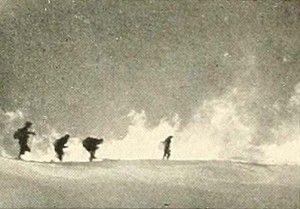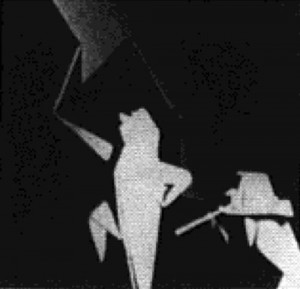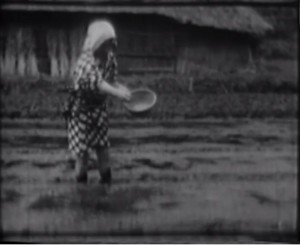"The Legend of San San Ku was a practically unanimous choice as winner of the top award with its story of a Japanese legend. If the credits were to be removed from the beginning of this film, it would be hard to believe that it was not made in Japan. It was a very ambitious production for a crew of amateurs to undertake, and they came through with flying colors. Here's 20 minutes of Japan that is delightful to experience" PSA Journal, Oct. 1968, 48.
"Monkey's of the Snow Mountain is a touching film of northern Japan produced by Masatoshi Okochi of Japan. You will never believe how sorry you can feel for a tribe of monkeys in 15 minutes of snow, snow and more snow. The film is in color, mostly white. It took four years to film the seasonal cycle in its fullest. Here we have suffering not only by the subjects of the film but by the film maker as well. In spite of that, you'll enjoy it" PSA Journal, Nov. 1969, 57.

"A down mountain ski run, etched against a filtered sky and set in a world of fantastic snow shapes and incredible beauty, is the theme of Mount Zao, which was filmed on the Japanese mountain of that name. Khoji Tsukamoto has mastered the technique of back lighting the dramatic turns, stems and jumps of a down mountain run so that they are framed against luminous clouds of powdered snow. The ski runners are always preceded by an ubiquitous cameraman who has invariably chosen the most effective angle for each scene of his closely knit sequences. The result is as smooth a picture of skiing as the screen has seen. In sequencing, editing and the nuances of tempo, this film is near the top. And particularly praiseworthy is the way in which the cameraman has involved backgrounds of astonishing natural beauty with foregrounds of interest compelling action." Movie Makers, Dec. 1937, 603, 626.
"Photographed against the variegated background of Japanese life In Southern California, "Nisei Parade" strives to follow the lives of three nisei youths and of a girl, the sister of one of them, who returns to California after attending school in Nippon. The two young men, Ikuo and Sueo Serisawa, have taken their camera and their script into every phase of Japanese life into America. The story is centered on Jiro, one of the three nisei who is employed in one of the many huge produce markets in Southern California, and who is torn between the choice of a career as a photographer necessitating years of study, and his love for Sumi, the girl. It is the story also of George and Shig, the other two youths. The roles are capably portrayed by Tadashi Kamayatsu, Alice Iserl, Peter Takahashi, and James Sujishi. Although taken on 16mm. stock, and although it is a silent, film utilizing Japanese and English titles, "Nisei Parade" won praise for its photographic excellence when shown before various American groups, including MGM." The New World Daily News, March 14, 1935, 1.
"J. R. Derisowa [sic] received honorable mention for his 2000-ft. picture, 'Nisei Parade'. As a general rule it is difficult to maintain interest through five reels of pictures." American Cinematographer, Feb. 1936, 73.
"Orient–Old and New–Japan is an excellent travelog of this oriental island in the well known superb Ross style. Narrated by his wide, we are taken to many of the well known spots on the island, and shown some of the more unusual places of interest. The commentary is full of factual information which gives the film an exceptionally good pacing" PSA Journal, Sept. 1964, 50.

"Many forms of art originated in old Japan. Here is a demonstration of a unique and improbably one that began as entertainment for children. Origami, the art of paper folding, is charmingly portrayed and described in this very imaginative film. One of the Ten Best, it will be enjoyed in the 1963 Top of the Ten pack" PSA Journal, Oct. 1963, 40.
"Rice and Farmer depicts the life and toil of the Japanese who raise rice for a living. Ueda, who made the film, has a keen eye for composition. Few filmers today pause long enough to look for a pleasing view through the lens before pressing the trigger, but this is one of Ueda's strong points, and his film is a joy to see for this one aspect alone" PSA Journal, Aug. 1967, 37.
"Rice Harvest in Japan by James and Veda Linford, PSA members of Oakland, Calif. The Linfords have presented another pirze film to go along with their former winners. This 8-minute 16mm film was awarded a Ten Best Medal" PSA Journal, Nov. 1971, 41

"Documentary: On the life of rural rice farm families in Japan." National Archives.
"Okamoto's heroine was a Japanese girl making a doll as a birthday present for a friend. Pictorial values, backgrounds of the Japanese countryside in spring, and the delicate grain which Cinematographer Okamoto had achieved gave his film distinction." American Cinematographer, Feb. 1935, 78.
"'Tender Friendship,' in 150 feet of 8mm film, was sensational from the photographic standpoint. Its sheer beauty, its poetic rhythm both in story and photography, made it one of the outstanding pictures of the contest" American Cinematographer, Dec. 1934, 365.
Total Pages: 3